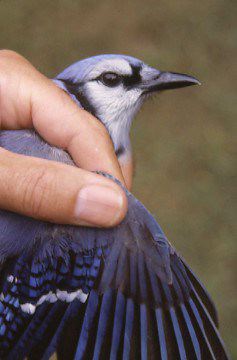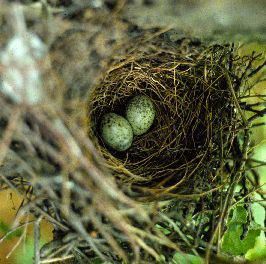- RESEARCH -
BLUE JAY
Cyanocitta cristata

All photos & Text © Hilton Pond Center
Brownish-tipped alular feathers and
unbarred primary coverts show this to be a
young Blue Jay. By the summer of its second
year, these will be replaced by feathers matching
the barred and darker blue secondary coverts.
During 1979-1983, nearly 1,000 free-flying and nestling Blue Jays, Cyanocitta cristata, were color-marked by Bill Hilton Jr. in an oak savanna and adjoining suburban residential area in central Minnesota. Work was based at Cedar Creek Natural History Area and was conducted as thesis research by Bill Hilton Jr., executive director of Hilton Pond Center for Piedmont Natural History. Jean Vesall, an independent bander whose home was adjacent to Cedar Creek, was a collaborator on parts of the study and banded additional jays on her permit.
Plumage (see photo above) was used to age each bird as HY (Hatch Year), SY (Second Year), or ASY (After Second Year), and most were sexed conclusively by laparotomy. Radio transmitters weighing 5g were mounted on six resident jays in 1980 using elastic harnesses; the radios proved to be essentially useless for tracking because of dense evergereen and deciduous vegetation that blocked signals.
Within a 60-hectare site, 121 nests were found in 1980, of which 27 were successful; in 1981, 29 of 181 succeeded; and in 1982, 21 of 101 nests yielded fledglings. Another 30 nests were found during a brief survey in 1983. This concentration may be the densest known nesting populations of Blue Jays.
 Many nest losses apparently were due to predation by Common Crows (Corvus brachyrhynchos), free-roaming cats (Felis domestica), or gray squirrels (Sciurus carolinensis). Jays were not observed to cannibalize their neighbors.
Many nest losses apparently were due to predation by Common Crows (Corvus brachyrhynchos), free-roaming cats (Felis domestica), or gray squirrels (Sciurus carolinensis). Jays were not observed to cannibalize their neighbors.
Mated birds were studied to determine duration of pair bond, re-nesting, multiple brooding, and ages of paired individuals. Some pairs remained together at least three years, often attempting at least two re-nests without pair bond dissolution, and showed only one incidence of double-brooding after a successful first nest. With one exception, known pairs consisted of "same age" jays (i.e., SY with SY, ASY with ASY).
Resident pairs showed high nest-site fidelity from year to year, particularly when they successfully fledged young; some nest-site selections implied cultural transmission of information. Residents bred earlier than apparent migrants and showed greater nesting success. Nest helpers and male incubators/brooders were never observed. Most of the 276 nestlings banded in 1980-1982 apparently dispersed or died, with few of them overwintering on-site.
Beginning in 1983, the jay population in the Cedar Creek study site nearly collapsed from unknown causes, and spot checks by additional observers in later years never showed nesting densities at the high levels observed in 1979-1982.
Upon his return to South Carolina, Hilton attempted to continue his jay work at Hilton Pond Center, including color-marking of captured individuals. Although a few nests were found and 468 jays were banded from 1982 through 2001, the small sample size and declining annual numbers of Blue Jays led Hilton to abandon work on the project as he moved on to hummingbird and Carpodacus finch research.
Back to Hilton Pond Introduction
Back to Bird Research Page
This Week at Hilton Pond
is part of the

Nature Blog Network
If you found this information useful or interesting, please
Support
Hilton Pond Center for Piedmont Natural History
It's painless, and YOU can make a difference!
Just CLICK on a logo below.
|
Make direct donations on-line through
Network for Good:
|
|
|
LIKE TO SHOP ON-LINE?
Donate a portion of your purchase price from 500+ top on-line stores via iGive:
|
|
|
Use your PayPal account
to make direct donations:
|
|
 You can also
You can also
post questions for
The Piedmont Naturalist
|
|
Search Engine for
Hilton Pond Center
|
 Hilton Pond Center for Piedmont Natural History is a non-profit research & education organization in York, South Carolina USA; phone (803) 684-5852. Directed by Bill Hilton Jr., aka The Piedmont Naturalist, it is the parent organization for Operation RubyThroat. Contents of this website--including articles and photos--may NOT be duplicated, modified, or used in any way except with the express written permission of Hilton Pond Center. All rights reserved worldwide. To obtain permission for use or for further assistance on accessing this Web site, contact the Webmaster. Hilton Pond Center for Piedmont Natural History is a non-profit research & education organization in York, South Carolina USA; phone (803) 684-5852. Directed by Bill Hilton Jr., aka The Piedmont Naturalist, it is the parent organization for Operation RubyThroat. Contents of this website--including articles and photos--may NOT be duplicated, modified, or used in any way except with the express written permission of Hilton Pond Center. All rights reserved worldwide. To obtain permission for use or for further assistance on accessing this Web site, contact the Webmaster.
|

 Many nest losses apparently were due to predation by Common Crows (Corvus brachyrhynchos), free-roaming cats (Felis domestica), or gray squirrels (Sciurus carolinensis). Jays were not observed to cannibalize their neighbors.
Many nest losses apparently were due to predation by Common Crows (Corvus brachyrhynchos), free-roaming cats (Felis domestica), or gray squirrels (Sciurus carolinensis). Jays were not observed to cannibalize their neighbors.


